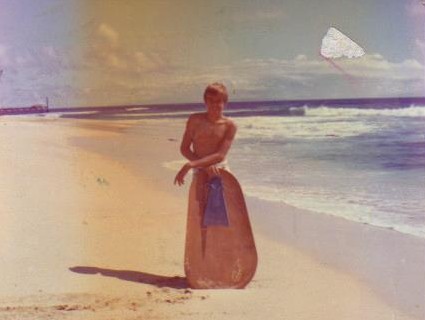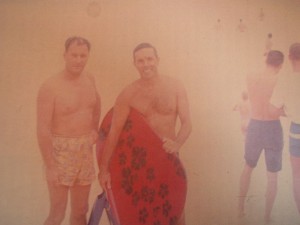3. What was John’s surfing like?
He
was incredible, I watched him many times in 20-foot plus waves. The biggest
ones maybe were at Sunset. I’d see him at Waimea. I went out with him
at Waimea one time in an outrigger canoe. He said, “Do you want to go
out there with me and ride a wave?" We did that together. He bailed out
the back and I took the canoe down to the trough and all I could see
looking back was him leaping off the back. We had fun. We tried
different things. I sailed with him, the canoe thing was interesting.
But he surfed some really big waves at Sunset and in a 35-year swell at
Sandy Beach on the East side. Sandy Beach looks over to Molokai and
that day was epic. Greg Noll and Buzzy Trent, all the big gun guys that
I surfed with later on. I had my big gun board. They were all out
there. Greg Noll, he flew over all the way over from California just to
catch it that day. John on that day, he bit through his lip, bouncing
down with the paipo. Huge bouncy waves, glassy, eerie.
What was his approach to riding waves?
The
way he rode it? He would use the rail, and primarily his arm, his
outrigger arm. He had this whole big deal with it. He would put the
inside arm on the wall, he used it as leverage and scooted way up high
on the paipo using the outside arm to dig the board into the wall,
giving it suction, sticking like a fin. He’d just do the switch when he
turned. He could do 'S-turns' down Sunset with that thing before it even
broke.
What do you mean by doing the switch?
Grabbing
the rail from one side to the other, one arm is always projected out on
the wall, kind of touching it, feeling it, so you know where you are on
the wall. He was incredible. I spent hundreds and hundreds of hours out at
Makapu`u.
When did you last surf with John? How long were surfing with him?
I
got my big gun board and was surfing it 1965-1966. He was still around 1965.
Then I sailed with him on P-Cats, Pacific Catamarans. I had an El Toro.
I know he was the Commodore of the Waikiki Yacht Club for a while. Then
I went on my different surfing, I went on big waves, big guns. I played
with the paipo quite a bit, at Point Panic and all after that. But I
liked to get the big waves on the stand-up boards. More because I got
caught out on a really big day on the paipo. It was ludicrous, I was
out with John and he took me out a 10-foot day at Sunset. It turned from
10-foot to 20-foot, from 20-foot to outside 40-foot They all went in and I went, “Oh my
God I’m out here on a paipo all on my own.”
That doesn’t sound like fun.
I
just kept going out to sea. It was so scary. John kind of saved me by
directing me to go over to the point, where I would have to take a
beating and come in. Otherwise I would have ended up in Kauai or some
place. It was one of those Sunset days that are too big. That was the
last time I actually rode big waves on the paipo. I more or less rode
my Greg Noll.
Rainer at Sunset Beach on "a very good day" in the mid-1960s.
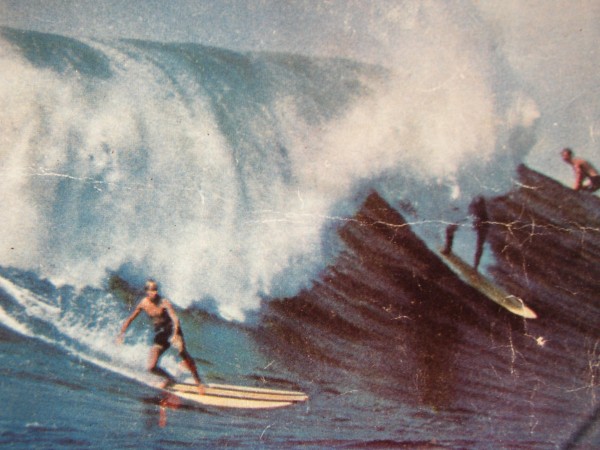
Photo Don James.
Rainer riding Sunset on his Greg Noll gun.
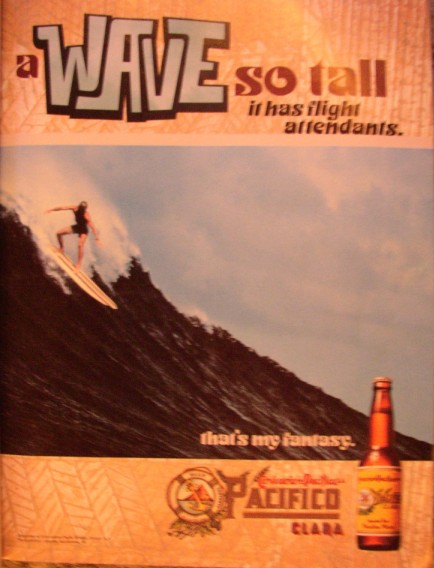
Photo Don James.
4. Did John give you advice on riding a paipo or did he just say go out there and do it?
We’d
just go out there and he’d show me about the diving. The really
interesting part was how good they could dive under a 20-foot wave in
trouble. You could pump ‘em as you were going down, sort of like you
step your way under and deeper, deeper and deeper. Maybe harder with a
wetsuit, but with your bare skin you could down under a under a huge
wave and come up safe. They are good to duckdive. He taught me that
riding it underwater was as important as riding it above water. He
was a very incredible guy. I watched him bodysurf at Makapu`u without
a board on his back with his son sitting on his stomach.
I’ve had some contact with Stig.
He was just a little baby then and I was a grom.
Makapu'u beach in the 1960s.

Photo H. Stegemann.
5. Paul Lindbergh described surfing with you at Makapu`u on a massive day. Do you recall when this was and much about the day?
I
don’t remember the date, I just remember that we went out and charged
that day. Looked at each other and just said, “we should give it a
try.” It had huge peaks in the middle, peaks on the left and on the
right. It was doable for a paipo. We caught a few. It was really big.
Really dangerous. Somebody else lost their life the day before, they
got swept out I think.
Paul said it was as big as it gets.
It
was taking a chance. When there you have these beautiful glassy peaks
in the morning that would take you to the beach, it is worth trying.
Were you surfing one of Paul’s boards or one of John’s boards?
I
had a Paipo Nui, a real skinny one made by Val Valentine. It was
laminated. It almost looked like a skateboard deck now. They had a logo
on them of a wave going over a guy. Val was a cool dude. Val and John worked together on them, but John was the inventor as far as I know. .
What do you call real skinny?
How
thin? A little over a one-quarter inch. He laminated them on a mould.
Each sheet of thin veneer he would press it down, then glue it down
with waterproof glue, then glue another sheet down and another sheet
down. Then pop it off, trim it, sand it and varnish it. Then it
would be ready to go. Fifteen dollars a piece. And you could ride that
sucker in 20-foot surf.
6. Who else was surfing paipo at the time?
Andre,
me, Paul. I don’t know if Paul’s brother, Bob, did. Maybe he tried it.
Paul’s brother and I became big wave riding buddies before he went to
Vietnam. I don’t know how much he rode the paipo. My friend, Jim Hayes,
who owns Tropical Blend Surfboards in Honlolulu, he rode them for a
while. I rode with all of John Waidelich’s friends. There was a group
like the Malibu group. The Paipo Nui group of Makapu`u. Every Sunday
they would be there. The kids and the dogs, straw hats, sitting on the
rocky point there. When you felt like it, you went out. You went in and
out, all day long.
Family
friends, Walter Pitzal and his wife, in the foreground and John
Waidelich's wife behind them (wearing a hat). The young boy is Stig
Waidelich and Rainer is on the rocks watching John Waidelich surf.
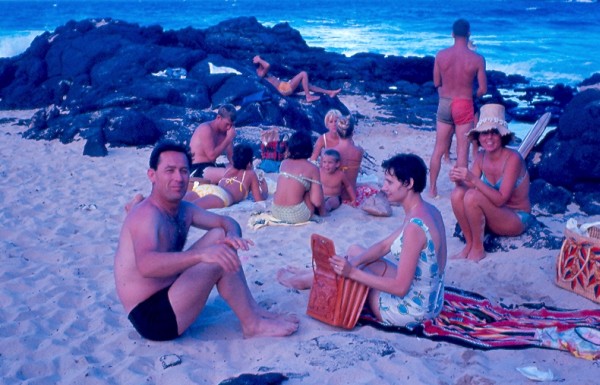
Photo by Rainer's father, Horst Stegemann.
Photo taken at Makapu'u during filming of a beach blanket movie. John Waidelich can be seen riding paipo in the background.
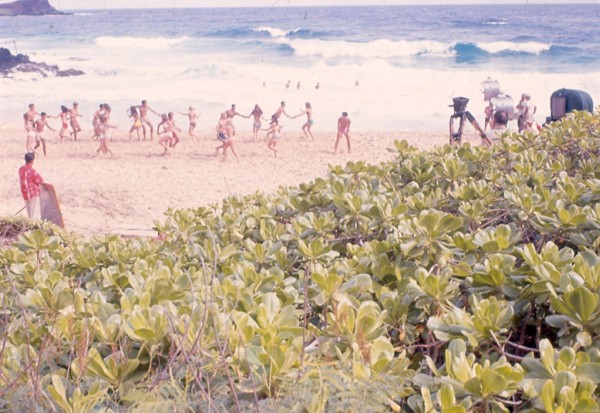
Photo by H. Stegemann.
He
had a Volkswagen bug. He must have designed the board to fit into the
trunk, because it fit perfectly. Two, three, four or five of them fit
in the Volkswagen trunk. That’s how I remember us going to Makapu`u, or
Point Panic, Sandy Beach, out there by Kahuku. We surfed Kahuku, nearby
was a beach break called Pounders, we paipoed there, too. We surfed a
lot of Laniakea. Laniakea was a really good place to do paipo, because
of the long walls. On the long walls a paipo just flys. It can be just
like an airplane if you can get it going fast enough. The other place
where they do have films of it, one of Val Valentine’s productions, it
shows John out-surfing, out-speeding any surfboard at Makaha side.
Maili Point. Before they ruined it, it was an awesome right. Val
Valentine has a movie of him screaming along, passing surfboards.
Offshore winds kind of thing, 8-foot, just grinding down the beach. Some
other places we paipoed in Hawaii ... Makaha, and John took me up to a
spot, up from Makaha called Yokohama Bay, that was like a secret spot. Big blue waves close to shore mostly lefts. John really ripped at that place.
Do you know the name of the movie?
I don't know the name of the movie. Val Valentine had a bunch of movies (see Note 4). He had this 16mm camera that he did it in. He was like Bruce Browne.
7. Did you ride Pipeline much?
I
rode it a quite bit with the paipo on the smaller days. I rode it about
15-foot with my gun, back in 1964, a 10'6’’ slot-bottom Greg Noll that I was riding.
A long board on a very steep wave.
Rainer on his 10'6" Greg Noll slot bottom gun, at Pipeline (top) and Sunset (bottom). Photos
taken by Bob Lindbergh (brother of Paul Lindbergh, creator of Hawaii
Paipo Design boards). Bob who later died in the Vietnam War, took the
photos with "his bull moose lens, he got surplus."
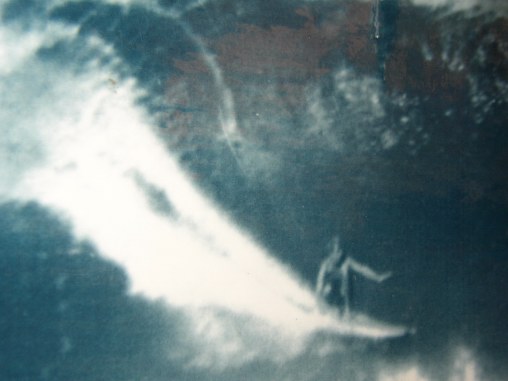
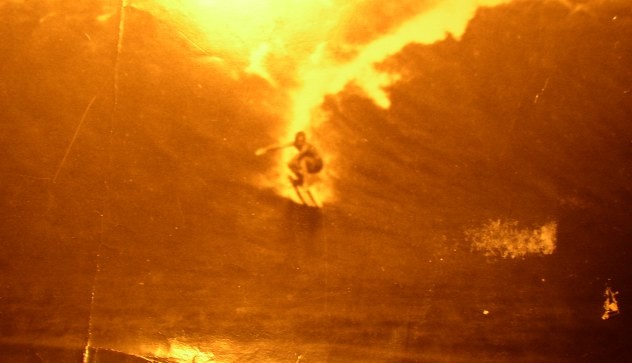
Photos by: Bob Lindbergh.
Was there a reason you didn’t ride the paipo on the bigger days?
Pipeline
was kinda scary. I don’t remember catching huge waves at the Pipe, on a
paipo. Maybe up to 10-foot. After 10-foot I wanted to go further out. To catch it a
little before, making your turn where those guys are sitting now, to
set yourself up. After that big, giant day with the paipo mishap where
I almost drowned, I kept it smaller on the paipo. It is really doable.
It is a very safe board but after three hours in the water I was
exhausted.
You probably had leg cramps.
I
had everything going wrong. Leg cramps, fear and everything. The Fire
Department was on the beach. A hundred tourists on the beach and John
waving a palm leaf telling me, “Go to the Point!” All I could think was, “Ok, ok, thanks a
lot, the point is hairy.”
8. When did you leave Hawaii?
I left Hawaii in 1972.
Did you go straight to Santa Cruz, or did you travel quite a bit in between?
I
travelled to Texas, then back over here and then I found Santa Cruz via
the boating thing and then I started on my sailboats and living on them
and stuff. Back then.
About
1994, I made a plywood paipo and just started doing it again. I still
have that. It’s a blue one. I just made it without a scoop or anything.
I could use it as a skim board or a paipo. But it didn’t have a scoop
on it.
Just flat?
To
put a scoop on it would take a series of plywood wings and shave them
down like John did. The way John did it was to have a flat board, then
he’d put a series of plywood wings – like steps going up and out, and
then sand them down to give him a scoop.
9. Where did you ride the board you made?
Right
here at Harbour Mouth, at Santa Cruz Harbour, is a good barrel. All the
way down the beach to Black’s Point is all good bodysurfing and
boogieboarding. Only a buddy and I are the only two in town who have a
paipo. My friend, Mr. Matt, he loves it. We go down to Black’s Point,
which is kind of a peak and we get barrelled and stuff. People all come
up and ask what are we riding. And I give them the story.
10. What sorts of waves do you think paipos are really best suited for?
A
big peak like Sunset style, big long wall. A beach break getting in the
barrel – the danger is getting hit in stomach with it, getting out of
breath. Getting buried in the sand on a big steep one. A big peak is
the best. You can go left and right, all over the place.
11. You ride longboards and guns. What is the attraction of paipo for you?
Oh, the speed. The speed is the most impressive.
12. Over the years, are there any waves or surfs you’ve had on the paipo that stand out?
The
one I had with Paul was a big standout. That was an epic day. Even that
big day with John Waidelich before when it was 10 to 15 feet. It was the most
beautiful day you could ever imagine before it went haywire, 30-foot plus or
something out there.
The
speed is just so incredible, you’re going on a 20-foot wave. It’s amazing.
If it’s smooth enough, you catch air, you’re gliding from one wavelet
to another.
13. In all the years you have been riding paipo are there any tips or technique that you have learnt -- the key to riding paipo?
The
biggest technique is swimming underneath the waves. It’s one of the
neatest and life saving, it’s smooth going under big waves. I never did
anything like spinners or anything non-functional moves on them. I
guess getting way up in front, most of the board is behind you, down
low by your chest. Getting way up front gives you the most speed.
You’ve probably seen some of John’s movies where you see how fast he
goes when he trims out.
In one video that Paul sent me (see Note 1)
there is a shot of John going left and right, all over Sunset. That was
from one of Val Valentine’s films. I was riding a gun that day, John
actually spun around behind me and he went to the right of me then back
across my tail to the left of me, and then went on. I’m dropping in on
my nice long board gun, my 10' 6". He was always zooming with around
me, he did that with everybody: “Look what I can do.” It was amazing,
like having a shortboard in those days.
14. They were doing things that people would be doing on shortboards, 20-30 years later.
I
figured that was what they were going to be doing. I watched some of
the people starting to build shortboards. The first shortboard I saw
was made of wood. You asked me a question about woodshop class. Paul’s
brother Bob, he built a wooden shortboard. Somehow I heard that it got
hurt in a fire or something. He had died in Vietnam, but somehow the
board got destroyed. He built a nice shortboard in that class. I didn’t
build a board -- I built a table. A mahogany table.
You can’t surf on that?
I
made a board at home, I made my boards at home. It was mahogany and
looked like an ironing board with a nose. Like the old Hawaiian style
alaia. That’s what I started on, even before I knew John.
How long were those boards?
About
4-foot, and a foot and a half wide. Not too wide. It hard a curved nose. And I
painted it up nice and bright, a nice painting job with stripes. We
were surfing the Wall there, Kuhio Beach. There is a sewer outlet
there. They call it the Wall, everybody knows it as the Wall. It’s a
stone structure and we surfed right out in front of that. It was
between Queens and Publics. That’s the first time I ever saw paipo. All
the kids would come out with their homemade boards. Some would stand,
some would not stand.
15. The Wall is where there is some footage of Val Ching riding a standup paipo.
I
seen that guy, he went over everybody. There were some serious guys out
there. There were some fights, things against the haoles. If you were a
haole and went out there you had to do some good waves, or they would
kick you out or run you over.
Sounds heavy.
There
were some heavy guys. But Val Ching he was cool. I saw a lot of guys
stand up like that. I tried it but my board was too narrow. I just
speeded along with it. That’s how I met John and he showed me a better
board. It was like on and on from there.
16. How old are you now?
Sixty-one.
17. How often do you get out on the paipo now?
I
try to go a couple of times a month. I still surf more because I
compete in longboard contests. I keep up to that. Next week I got a
contest at Pleasure Point. I’m going to take the paipo there to show it
off because a lot of guys haven’t seen it yet. Go to dirtfarm.com – there’s a surfing website for a bunch of old dudes that still surf and have a lot of fun with it (see Note 2).
I
do have a lot of pictures though not all of them involve paipo. Of the
beach scene at Makapu’u, some big wave shots at Sunset, looking out
from Val’s house of 20-foot waves that are just perfect, kinda like the
scene was in the 1960s. It was quite nice and there were no crowds.
Sunset shot from Val Valentine’s house perfect 20-foot day.
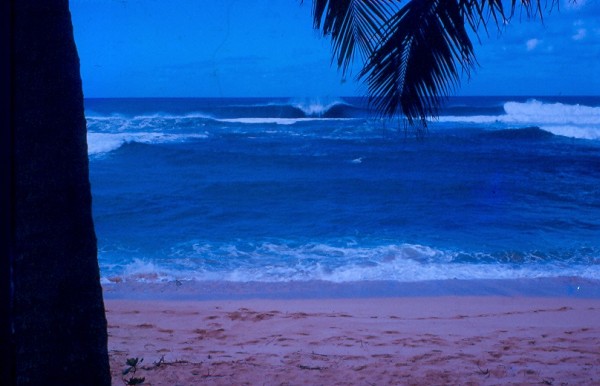
We’ll add some of those photos to your interview.
I
don’t know who has the Val Valentine’s photos -- you’d see a lot in that.
John was always out there, in between Greg Noll. You actually see him
in the movie, Ride the Wild Surf with Tab Hunter. There’s a scene that
starts in there at the front and you’ll see John Waidelich taking off
at the Sunset peak. It’s a little spot, but it’s there. I was there
when they filmed that movie. We were all trying to get involved.
John Waidelich in the take off from the movie Ride the Wild Surf. The other guys are big names like
Miki Dora.
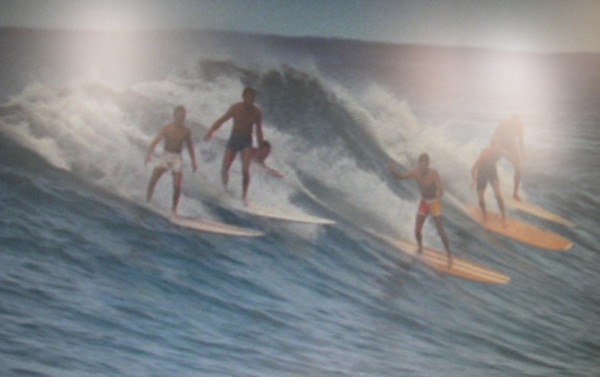
Hollywood at Makapu`u.
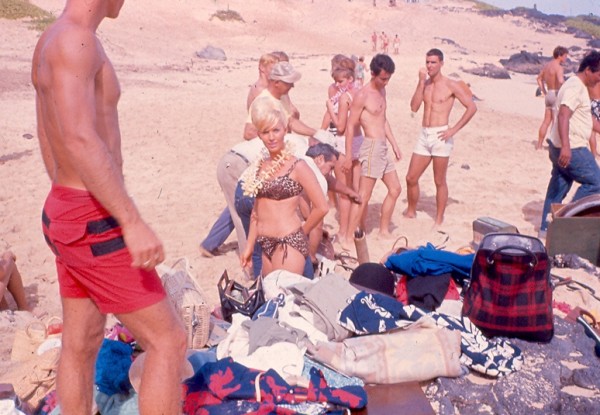
Photo by: H. Stegemann.
Somebody
must have them (Val Valentine’s movies). They’re classic. Some very
impressive days at Sunset. The craziest thing I saw John Waidelich do,
was dropping in at the same time a longboarder was at Outside Sunset
at maybe 25-foot. His fin got caught up the top and he got completely
covered up by the tube of this 25-foot monster. I was watching on Val’s
deck at the time when Val was filming it. The longboarder, he proned
out and he is riding this massive whitewater, crazy. All of a sudden,
coming out of the whitewater is John and he climbs up on top of the
guy’s back and rides with him for a while.
18. Were there any other comments you wanted to make about riding paipo or the times back then?
I
took my paipo to Molokai and rode by the leper colony. That was fun.
Little waves by the airport there. Sometimes I worked for this guy who
flew newspapers over there.
I
like the feeling of the freedom they gave you. The safety in the water
and then the speed. It’s totally awesome. You also got to work out a
different part of the body from paddling and surfing.
The speed is a common denominator amongst paipo riders.
The
way I see it, you are getting inside, just flying over the water.
You’re not bodysurfing. You get it just right on a smooth day and you
are going like a bat out of hell. It feels like you are superman going
right across the face. That feeling is awesome. You have to work at it
to get it, to be like that. A boogie board can’t get that. It’s as
smooth as can be. Flying.
You are also much lower in the water.
You
can do an Hawaiian pull-out. Are you familiar with an Hawaiian
pull-out? You bury the nose and pull it out the back of the wave,
and then kick like hell. You end up away from the vortex and pop up on
the other side and everyone thought you had just died. You can take
that into a pearl dive, in a controlled plane under the water. It’s
kinda hard to describe it, it just works that way. It works underwater
like it works in the air. If you do it right. You have to be going
pretty fast.
You got to have speed and bury the nose. Anything else?
You
have to pull into the wall and your outrigger arm has to skidder on the
wall. If you feel it in the elbow you know you are in the right place.
You can get a tube ride with it. If you don’t grab it in you slide out
sideways and you get killed. You lose that grip. John liked to favour
the rail a little bit, the inside rail. Everybody kind of followed what
he did, with that arm. He always told me about the arm, using the arm,
what he called the outrigger arm. Outside arm, bring it in close
depending on what you want to do.
What would happen if you moved it out versus move it in?
You
might drag a little more. You need as much weight forward, it’s like
riding the nose. It’s like doing a cheater five on a longboard. You
want to be up on the nose, your weight more in a trim place. You scoot
way up and you stick you arm way out. And you want to make sure that
your flippers are up, high and dry too. If you notice, he doesn’t drag
his flippers. It seems that they are not down in the water for steering
or anything. His flippers are up out of the water.
It is good to ask about these things as the technique gets lost, especially riding in big waves.
I
was out at Waimea with Andre Vega. I sent Paul a picture. I took a
picture in the channel of Andre dropping into a fair sized wave at
Waimea. It was a real bumpy day. I guess you just get in early, just
hang on and go. It’s so bouncy, on the way down you are going to hit 3-foot
chop. You are going to fly. You’ve got to aim for the next spot. It
seems like the whitewater never catches you. If you get it right you
are always in front of the whitewater. That’s the beauty of it.
A copy of the photo of Andre would be good.
It
was such a cool day. He went out early at dawn patrol. The only other
longboarder was Sammy Lee riding a white gun. Andre caught one right
off the bat. I had a Nikonis camera and took a shot of it. I was on a
surfboard with a camera. Then I put the camera back on the beach and
went out and surfed.
Waimea
from the side. Normally breaks right under a cliff. It’s pretty hairy.
If you don’t make it on the takeoff you end up on the rocks. I’ve seen
John’s board on the rocks there before. We took some pretty good sized
waves out there at Waimea.
Andre Vega taking off at Waimea: "We were the first out, a fearless Paipo rider."
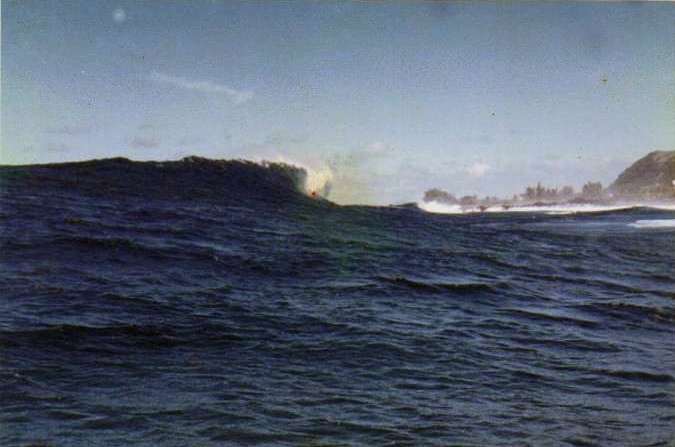
Photo by: Rainer Stegemann
19. Do you ever see paipos around these days?
You
don’t see them much here because of the cold water. A lot of boogie
boards. Rarely see another paipo. Me and Mr. Matt are the only two who
have them here right now. The bright red ones that Paul made.
You’re not riding the one you made?
No,
I made mine from memory. I thought I did pretty good but my dimensions
were off a little bit. In between surfing, bodysurfing and paipoing and
also skimboarding on it. We skimmed them too when we got bored. Those
thin ones Val Valentine made skimmed pretty good. You could skim them
down Sandy Beach into a nice big wave coming in. You’d get obliterated.
We’d call it whomping. Bodywhomping. “Let’s go whomping?" We’d
just go and get beat to hell.
20. Do you have any final comments?
I
wish John was still around. I wish more people would get into the
sport. Get into the real feeling of the water. The feeling of being
connected to the water. So close to it. It’s better than surfing, but a
bit harder work. It’s so close. Only inches from the water.
We also had crazy times on the big boards.
Now
I go surfing over to Cowells Cove. It’s only a short distance but I
just found out that three Hawaiian princes came over from Hawaii in the
1800s and surfed a place called Rivermouth. It’s a little wave over
from Cowells. A few weeks ago there were some guys with alaia boards
that they carved out of redwood, pine stringers, maybe 5’ long, 2’ less
wide. Ancient Hawaiian style, no fins, standing up, riding along,
sliding. There’s a big interest in the early boards. They saw the paipo
and said, “My God, that looks like a spaceship. The spaceshuttle was
designed that way.” You know John was a hydrodynamic engineer you know.
The delta wing shape?
The delta wing shape and it had something to do with the Volkswagen trunk.
And
one more important thing I want to say is. Thank you Paul, for those
radical big days we had. And a big thanks, for keeping the paipo alive (see Note 3).
The fastest board way ahead of its time.
Rainer's artwork
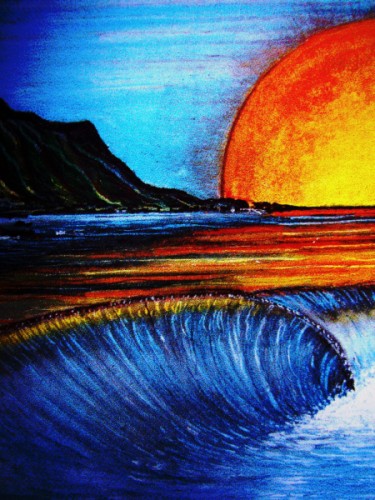
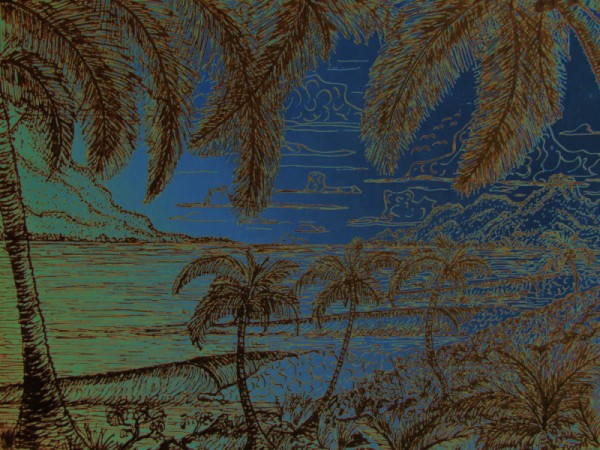
Note 1. See the video at http://vimeo.com/9742493.
Note 2. See the website at http://www.thedirtfarm.com/go_home.htm.
Note 3. Paul Lindbergh of Hawaii Paipo Designs.
Note 4. Val Valentine surf movies included: Northside Story (1963), The Call of the Surf (1964), Surfing Aussie (1965), and Outside (1966). See http://www.surfclassics.com/complete.htm.
|
